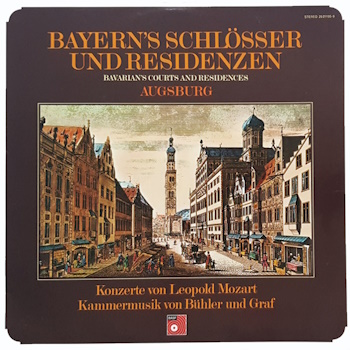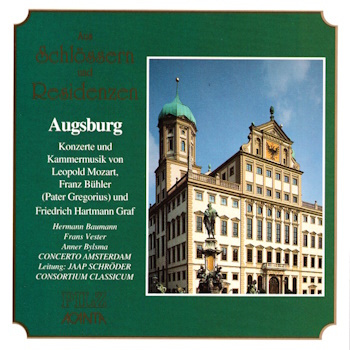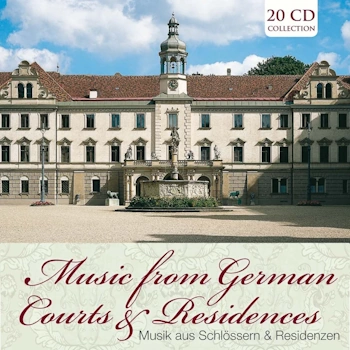 |
|
2 LPs
- 29 21195-9 - (p) 1972
|
 |
| 2 CDs -
44 2189-2 - (c) 1993 |
|
| AUGSBURG
|
|
|
|
|
|
|
|
| Leopold
MOZART (1719-1787) |
Konzert
Es-Dur für 2 Hörner, Streichger
und Basso continuo |
LP 1 |
|
11' 07" |
|
|
-
Allegro
|
|
4' 06" |
|
A1 |
|
-
Andante
|
|
4' 30" |
|
A2 |
|
-
"La caccia": Allegro
|
|
2' 28" |
|
A3 |
|
(Hermann Baumann,
Mahir Çakar: Horn)
|
|
|
|
|
| Leopold MOZART |
Sinfonia
di camera D-Dur für Horn, Violine,
2 Violen und Basso continuo |
LP 1 |
|
14' 18" |
|
|
-
Allegro moderato
|
|
4' 15" |
|
A4 |
|
-
Menuett |
|
3' 55" |
|
A5 |
|
-
Andante |
|
4' 16" |
|
A6 |
|
-
Allegro |
|
2' 11" |
|
A7 |
|
(Hermann Baumann:
Horn | Jaap Schröder: Violine)
|
|
|
|
|
| Leopold MOZART |
Sinfonia
burlesca G-Dur für 2 Violen, 2
Violoncelli, Fagott und Kontrabaß
|
LP 1 |
|
12' 29" |
|
|
-
(ohne Bezeichnung)
|
|
2' 24" |
|
B1 |
|
-
Menuett
|
|
5' 35" |
|
B2 |
|
-
Andante "Il Signor Pantalone"
|
|
2' 46" |
|
B3 |
|
-
"Harlequino" |
|
1' 43" |
|
B4 |
|
(Concerto
Amsterdam)
|
|
|
|
|
| Leopold MOZART |
Sinfonia
da caccia G-Dur für 4 Hörner,
Streicher, Pauken und Basso
continuo |
LP 1 |
|
11' 20" |
|
|
-
Allegro |
|
3' 36" |
|
B5 |
|
-
Andante, più tosto un poco
allegretto (a gusto d'un eco)
|
|
3' 38" |
|
B6 |
|
-
Menuett |
|
4' 15" |
|
B7 |
|
(Hermann Baumann,
Christoph Kohler, Mahir Çakar,
Jean-Pierre Lepetit: Horn) |
|
|
|
|
| Franz BÜHLER |
Grande
Sonate Es-Dur für Klavier,
Klarinette, 2 Hörner, 2 Violinen,
Viola und Violoncello |
LP 2 |
|
24' 10" |
|
| ("Pater Gregorius",
1760-1824) |
-
Allegro brillante
|
|
12' 22" |
|
C1 |
|
-
Romanze
|
|
5' 19" |
|
C2 |
|
-
Rondo: Presto
|
|
6' 27" |
|
C3 |
|
(Consortium
Classicum) |
|
|
|
|
| Friedrich HARTMANN GRAF
(1727-1795) |
Quartett
Nr. 2 G-Dur für Flöte, Violine,
Viola und Violoncello
|
LP 2 |
|
12' 42" |
|
|
-
Allegro moderato
|
|
5' 56" |
|
D1 |
|
-
Adagio
|
|
3' 21" |
|
D2 |
|
-
Presto |
|
3' 21" |
|
D3 |
|
(Frans Vester:
Flöte | Jaap Schröder: Violine |
Wiel Peeters: Viola | Anner
Bylsma: Violoncello) |
|
|
|
|
| Friedrich HARTMANN GRAF |
Quartett
Nr. 3 C-Dur für Flöte, Violine,
Viola und Violoncello |
LP 2 |
|
11' 20" |
|
|
-
Andante moderato
|
|
4' 47" |
|
D4 |
|
-
Allegro |
|
4' 08" |
|
D5 |
|
-
Finale: Non troppo presto
|
|
2' 12" |
|
D6 |
|
(Frans Vester:
Flöte | Jaap Schröder: Violine |
Wiel Peeters: Viola | Anner
Bylsma: Violoncello) |
|
|
|
|
|
|
|
|
| Leopold MOZART:
Konzert und Sinfonien |
Franz
BÜHLER: Grande Sonata Es-Dur
|
|
|
|
|
| CONCERTO
AMSTERDAM |
CONSORTIUM
CLASSICUM |
|
| Jaap SCHRÖDER,
Leitung |
- Werner Genuit,
Klavier
|
|
|
- Dieter Klöcker, Klarinette
|
|
|
- Werner Meyendorf,
Horn |
|
|
- Nikolaus Grüger, Horn
|
|
|
- Rainer Kussmaul, Violine
|
|
|
- Jürgen Kussmaul, Viola |
|
|
- Anner Bylsma, Violoncello |
|
|
- Jacques Holtman, 2.
Violine |
|
|
|
|
|
Recorded
at: |
|
-
|
|
|
Live / Studio
|
|
Studio |
|
|
Producer |
|
-
|
|
|
Balance engineer
|
|
-
|
|
|
First LP Edition
|
|
BASF
| 29 21195-9 | 2 LPs | durata
49' 14" - 48' 12" | (p)
1972
|
|
|
First CD Edition |
|
PILZ
- ACANTA | 44 2189-2 | 2 CDs |
durata 49' 14" - 48' 12" | (c)
1993 | ADD
|
|
|
Note |
|
-
|
|
|
|
|
Musik
aus Schlössernb &
Residenzen
(20 CD Collection)

Membran |
234355 | (c) 2016
(in CD 11
& 12)
|
Augsburg’s
golden age in the field of music
was the 16th Century. It was
then that the Free Imperial City
of Augsburg, the leading
metropolis of trade at the time,
was able to develop into one of
the most important centres of
music in Europe, a fact which
was due to no small degree to
the patronage of the Fugger
family. The Thirty Years War, as
well as political changes,
seriously affected the city’s
cultural life, however soon
after 1648 the interest in music
was revived anew. The Church was
now joined by the middle classes
in its efforts to foster music.
„This is not the place where
great singers or virtuosos can
be well paid. Rather, it is more
important that there are
musicians who love their art and
try to perfect their skills so
as to satisfy their own
keenness. As there is no
shortage of such persons,
various musicians can gain
honour in concert performances.“
This was written in a
contemporary city chronicle.
In 1712 Philipp David Kräuter,
the cantor and also one of
Johann Sebastian Bach’s pupils
founded a civil „collegium
musicum“, which attracted many
of Augsburg’s lovers of music
and professional musicians.
Leopold Mozart (1719-1787), the
son of an Augsburg bookbinder,
is bound to have received
considerable stimulation from
the activities of this group
during his years at grammar
school (up until 1737). Even
after shifting to Salzburg, he
still kept in close contact with
the group, which was reorganized
in 1752 and from then on was
called the „Music-making Society
at the Baker’s Hall“
(„Musikübende Gesellschaft zum
Beckenhaus“). Once a week music
was played in the guildhall of
the Augsburg bakers. Music was
also played before a large
audience at the inn „Zu den drei
Königinnen“. In charge of this
„eminent and praiseworthy
collegium musician „ (Leopold
Mozart’s words) was Anton
Christoph Gignoux who, according
to Mozart, „could not be spoken
of highly enough“. Gignoux, an
Augsburg manufacturer of calico
and an amateur painter, was on
friendly terms with the Mozart
family. The orchestral works of
Leopold Mozart enjoyed a high
degree of popularity at this
„Music-making Society“. In 1756,
the year in which Wolfgang
Amadeus Mozart was born, the
divertimento „Die
Bauernhochzeit“ („Peasant
Wedding“) and „Die musikalische
Schlittenfahrt“ („Musical
Sleighride“) were accorded
abundant applause when first
performed at society concerts.
As a result the Salzburger „by
choice“, who was held in very
high opinion in his native town,
was asked to send more of his
„musique“ to Augsburg. We can
therefore assume that works such
as the Concert for two Horns
(1752), the Sinfonia di Camera
with a solo violin and a solo
horn (1755), the Sinfonia da
caccia or Hunting Symphony
(1756) and the Sinfonia burlesca
(1760), remarkable for the
absence of violins in the
orchestra, were also heard here.
The works referred to last were
closely related to the popular
symphonies „Peasant Wedding“ and
„Musical Sleighride“. A certain
instruction should be followed
when playing the Hunting
Symphony, the first movement of
which is distinctly reminiscent
of the Volkslied („folk song“)
„Frisch auf zum fröhlichen
Jagen“. According to the
instructions given, it is
necessary to have „several dogs
which bark, the others must cry
together ho ho etc., however
only for 6 bars“. The Sinfonia
burlesca indicates close
relationship with the Comedia
dell’ arte by virtue of the
headings for movements 3 (II
Signor Pantalone) and 4
(Harlequino). It may have been
the music accompanying a
pantomime.
Among the composers in Augsburg
Friedrich Hartmann Graf
(1727-1795), the musical
director of the Lutheran
churches, was one who, above
all, was regarded very highly.
He came from Thuringia, had been
in charge (for a time) – with
Georg Philipp Telemann – of
public concerts in Hamburg and,
after lengthy and successful
travels throughout Europe as a
virtuoso flutist, was called to
the Free Imperial City of
Augsburg. In 1779 Paul von
Stetten said the following about
Graf s works for the flute: „The
compositions for his favourite
instrument are highly regarded
by flute experts and are
exceptionally popular,
especially in England, Holland
and Switzerland, as well as at
German courts“. Graf – whom W.
A. Mozart had judged too
critically after their meeting
in Augsburg in 1777 – set up a
general „city concert
enterprise“ in 1779. He later
succeeded Johann Christian Bach
as head of the Professional
Concerts in London, was awarded
a doctor of music from Oxford
University and became an
honorary member of the Musical
Academy in Copenhagen,
Franz Bühler (1760-1823), a
generation younger than Graf,
became Cathedral Kapellmeister
(„musical director“) in 1801 and
thus occupied the most important
position in Augsburg as far as
catholic chapel music is
concerned. As P. Gregor he had
been a Benedicter for 10 years
at the monastery „Hl. Kreuz“ in
Donauwörth. Released from the
Benedictine Order in 1794, he
had then become an organist in
Bozen. His numerous musical
works for the Church, which were
written with a light hand, were
well-known for a long time
throughout Southern Germany and
beyond. Bühler’s instrumental
compositons were less well-known
however; the Grand Sonate for
piano, clarinet 2 horns and
string instruments, which was
published in 1804, is the most
noteworthy of all these
compositions.
Robert Münster
|
|